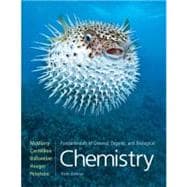With a focus on problem solving and engaging discussions of relevant applications, this volume effectively covers the essentials of allied health chemistry and puts it in the context of everyday life.
KEY TOPICS: Measurements, Atoms and Elements, Nuclear Radiation, Compounds and Their Bonds, Chemical Reactions and Quantities, Energy and Matter, Gases, Solutions, Chemical Equilibrium, Acids and Bases, Introduction to Organic Chemistry: Alkanes, Unsaturated Hydrocarbons, Alcohols, Phenols, Ethers, and Thiols, Aldehydes, Ketones, and Chiral Molecules, Carbohydrates, Carboxylic Acids and Esters, Lipids, Amines and Amides, Amino Acids and Proteins, Enzymes and Vitamins, Nucleic Acid and Protein Synthesis, Metabolic Pathways for Carbohydrates Metabolic Pathways and Energy Production, Metabolic Pathways for Lipids and Amino Acids.
A useful reference for allied health professionals.
For two-semester/three-quarter courses in General, Organic, and Biological Chemistry, primarily taken by allied health majors. Also suitable for one-semester courses with a comprehensive approach.
This best-selling text bears the hallmark of all John McMurry's books. On style, it is concise and avoids the 'wordiness' of most GOB texts. On substance, it is unusual in its balance of chemical concepts to explain the quantitative aspects of chemistry, and provides greater depth of insight into the theoretical chemical principles.
This makes for a wider spectrum of the different angles from which to view chemistry, and thus, captures a greater number of students who can successfully learn from the book. Demanding, yet logical, it also sets itself apart by requiring students to master concepts before they can move on to the next chapter.








